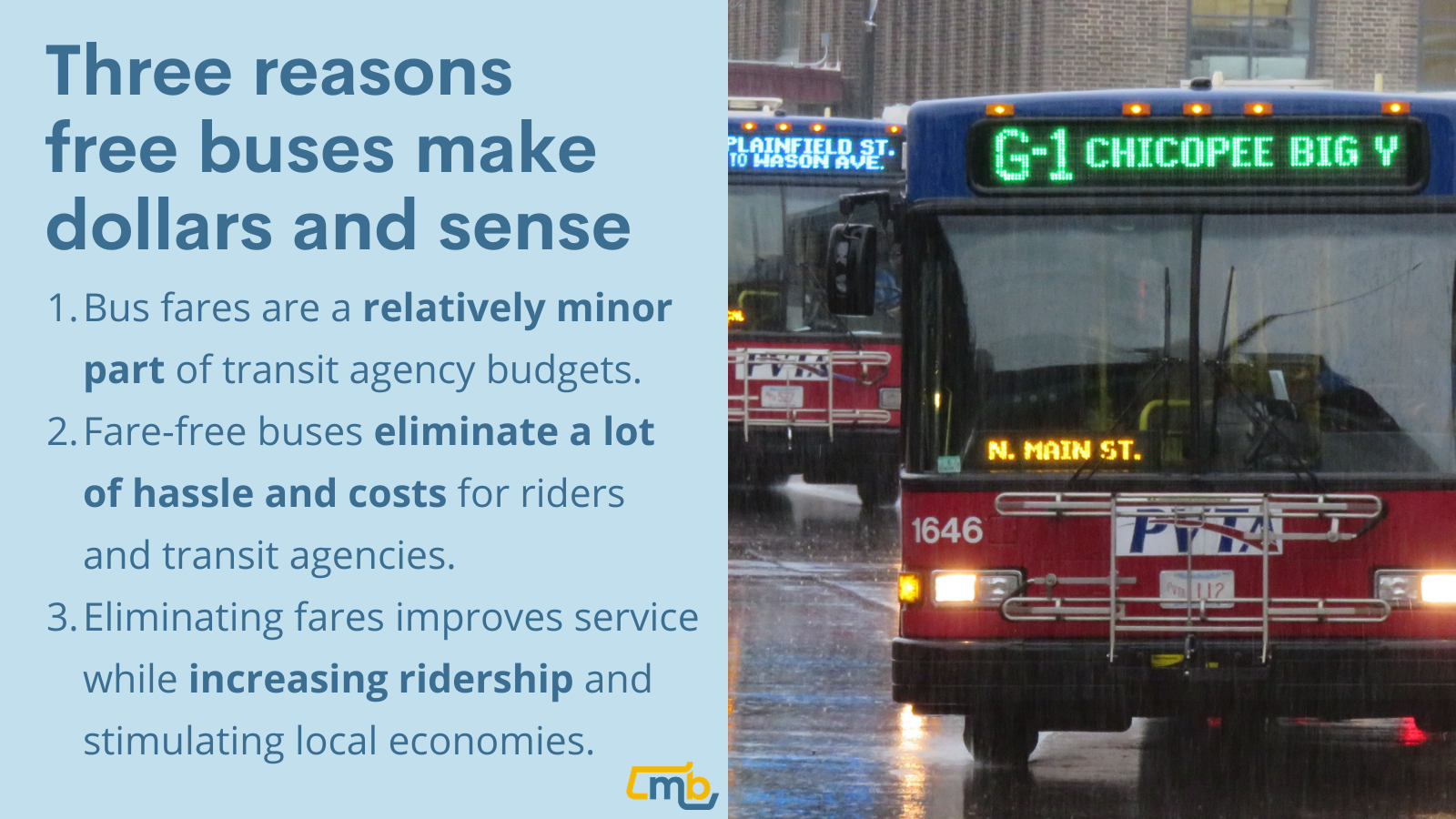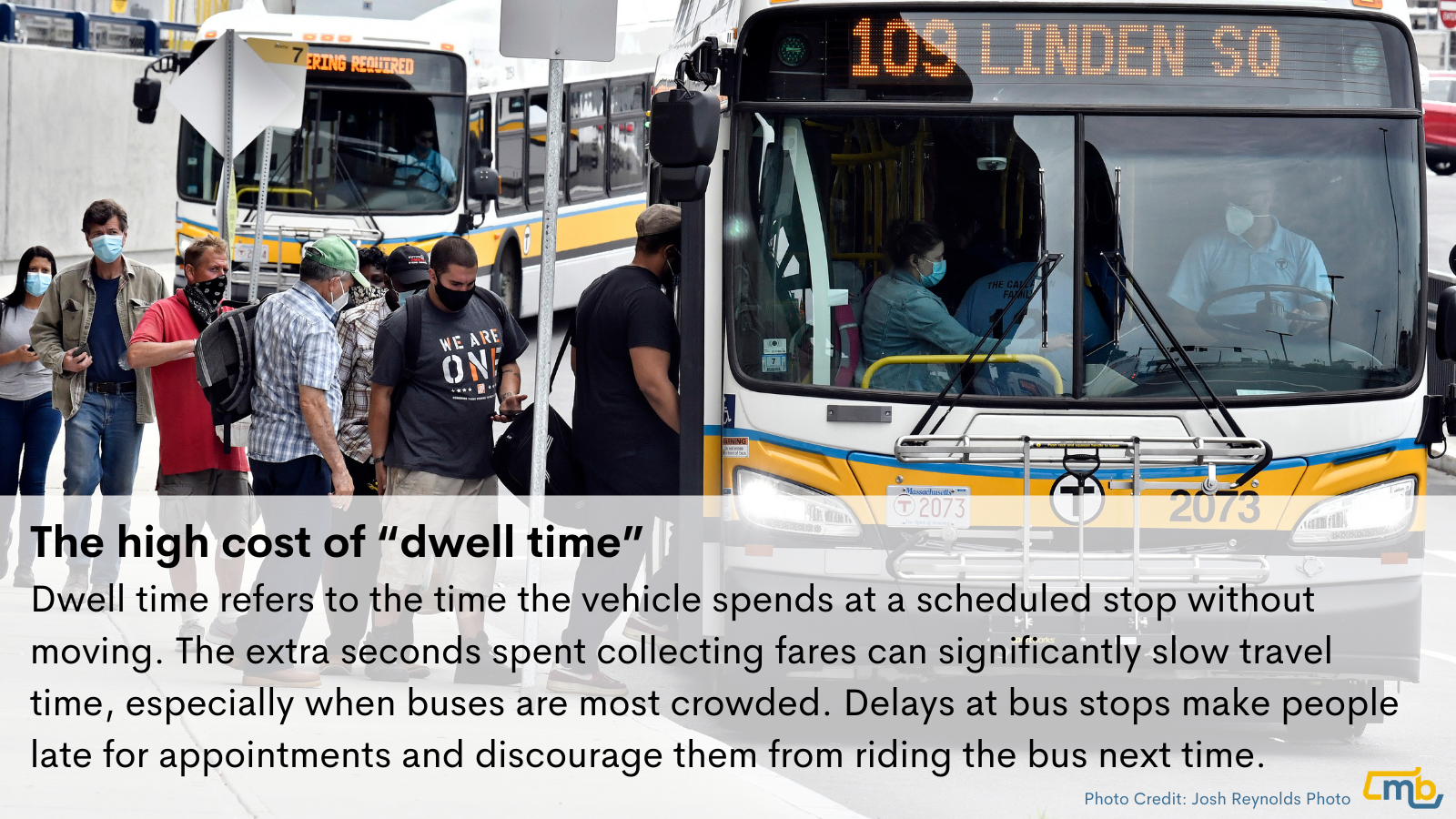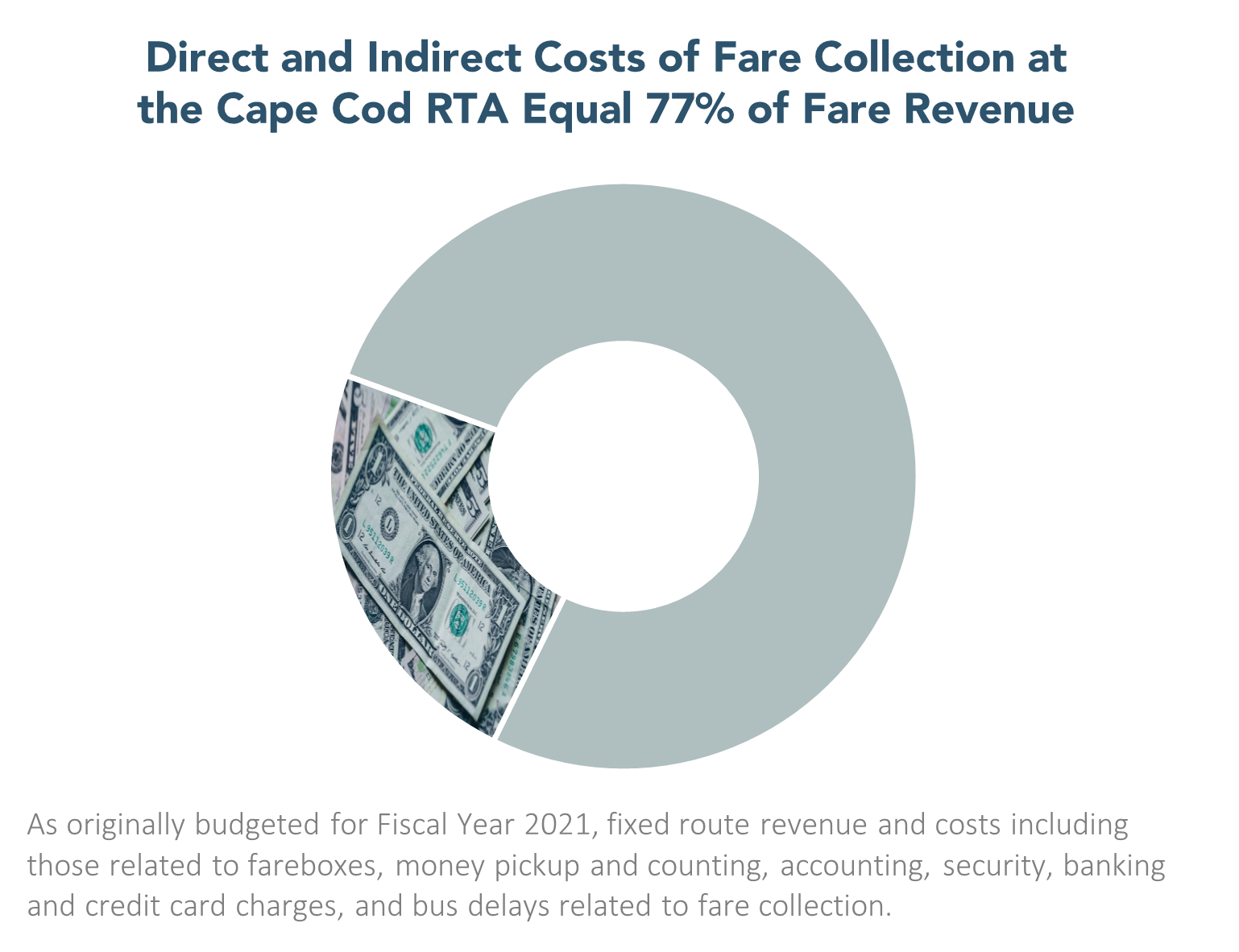There are many reasons to eliminate transit fares, especially on buses. In addition to advancing equity and reducing climate change emissions, fare-free service is more efficient, faster, and more convenient. Eliminating fares also increases transit ridership and helps stimulate the local economy. The major rationale for continuing to require fares is that officials have become accustomed to counting on this traditional – although relatively minor – source of revenue.

Bus fares are a relatively minor part of transit budgets
Public transportation is a public good that is mostly funded by public support. Most funding for transit authorities comes from the state, local, and federal governments. Bus fares are a particularly small part of the budget.
At the Commonwealth’s 15 Regional Transit Authorities (RTAs) that serve outside the MBTA area, total revenue from bus fares represents a little under 8 percent of total funds expended (ranging between 3 percent and 21 percent, depending on the RTA), based on 2019 federal reporting. More narrowly, bus fares represent a bit under 10 percent of operating expenses. Eliminating fares on RTA bus routes in 2019 would have saved riders about $23 million.[1] By comparison, this amount is a bit more than the revenue the Commonwealth chooses to forego by exempting aircraft and aircraft parts from sales taxes.
In the Boston region, eliminating MBTA bus fares would also be a relatively small share of the transit agency’s $2.12 billion operating budget enacted pre-COVID for Fiscal Year 2020. And fare revenues do not contribute at all to the MBTA’s separate capital investment budget, for which $1.47 billion was planned for Fiscal Year 2020. Ending bus fare collection would lead to less revenue loss for the MBTA than might be expected because the system is designed to feed riders into the subway and commuter rail system where free bus riders who transfer to or from rail service would still need to pay a full fare.[2] Transit experts working with the nonprofit group LivableStreets Alliance estimated that eliminating fares on local buses (excluding the Silver Line and pricier special express buses) would result in $33.7 million in lost revenue. This does not include the potential cost of running additional buses to accommodate increased numbers of riders. Actual fare loss would likely be somewhat higher because some riders with alternative route choices would switch from rail transfers to free bus travel.[3] Even if the actual fare revenue loss would be twice as high, it would still represent less than 2 percent of the MBTA’s combined annual operating and capital budget.
MBTA officials have suggested that, due to federal rules limiting maximum fares for separate paratransit service for riders with disabilities to twice that of a transit fare, the elimination of bus fare collection could indirectly require the authority to also eliminate fares on paratransit service. This does not seem to have been the case for other fare-free transit service around the nation. If it did occur, the MBTA would forego paratransit fare revenue, which amounted to $6 million in 2019.[4] MBTA officials have also expressed concern that if people with disabilities were no longer constrained by fare prices, they would travel more with paratransit. This improvement in equity could potentially lead to significantly larger increases in costs to accommodate the increased mobility. The authority has not yet provided formal estimates of the costs or benefits.
Eliminating fares improves service and avoids costs
Transit fares require their own infrastructure and staffing to sell, verify, and enforce payments. These activities divert time and resources away from the task of transporting passengers. The systems also slow down transit service and make it less reliable and convenient.
The seconds it takes for each passenger to pay their fare adds up, especially when a bus is crowded. It takes more time when riders have trouble finding or completing their payment or argue with the driver about the fare. A study by the National Association of City Transportation Officials (NACTO), found that on busy routes the time spent waiting for passengers to board and depart the bus, known as “dwell time”, can be as much as one-third of bus travel time. Dwell time becomes a more severe problem as more riders use a bus, losing more aggregate travel time on exactly the most crowded bus trips and stops where delays impact the most people. The higher the stakes for rapid travel, the slower the bus becomes.

The additional dwell time created by fare collection has even spurred some cities to make major investments to move fare collection off the bus. Some have constructed bus stations like those underground on the MBTA’s Silver Line, which enables passengers to spend time paying before the bus arrives. Other transit systems have done away with fare boxes on buses but hired fare inspectors who travel about verifying that riders have proof of having paid their fare and issuing fines to those that have not. These strategies, though costly to implement, also cut dwell time by enabling passengers to board the bus through both the front and back doors, an advantage that is also achieved by eliminating fare collection altogether. The NACTO study examining seven North American cities that implemented these measures found that these changes “cut dwell time substantially, leading to more competitive travel times, greater reliability, and growing ridership in every reviewed example.”
The MBTA is in the midst of creating a new fare system, for which official estimates of the costs paid to the contractor have grown to about $600 million to install the system, plus an average of over $33 million each year to operate. Thus, in over a decade the MBTA’s nearly $1 billion direct cost of fare collection will amount to approximately $190 per resident in the metropolitan region. This calculation does not include the cost of lost time to riders due to fare collection or the cost of additional new systems. Riders will be able to enter any vehicle door, though they will no longer be able to tap a single card multiple times to pay multiple fares for multiple riders. The fare collection will require new digital payment systems and a parallel system of kiosks to provide adequate access in all neighborhoods for riders who pay with cash. The MBTA will also create, train, and pay new staff to travel throughout the regional system confirming that riders have paid their fares and issuing fines to those who have not. In addition, the MBTA will also need to devote resources to ensure that travelers’ payment information and daily travel information doesn’t fall into the wrong hands.
Another indirect cost of fare collection is the time and effort required for agencies to administer – and for different categories of riders to obtain – different fare prices. The RTAs administer their own systems of fare discounts and the MBTA manages a variety of different programs. The MBTA administers discounted fares for students under 12, low-income youth, seniors, people with disabilities, and Medicare card holders. Almost 16 percent of trips used discounts in Fiscal Year 2019. Meanwhile, riders with documentation showing they are blind or visually-impaired travel free. The MBTA’s Corporate Pass Program, recently renamed Perq, meanwhile provides employees, mostly at large corporations, with cards enabling substantial tax benefits on monthly pass purchases.
Even the most direct costs of maintaining fare systems add up. King County Metro in Washington State estimated that the direct costs of just enforcing transit fares was $1.7 million annually. A May 2019 study by the Worcester Regional Research Bureau found that the Worcester Regional Transit Authority estimated the amortized annual cost of purchasing fareboxes at $100,000, their maintenance cost at $500,000, and the cost of staff processing payments at $250,000. Together that represents 28 percent of the WRTA’s fixed route fare revenue of about $3 million. In other words, for every dollar the Worcester RTA requires its (generally lower-income) passengers to pay in fares, the authority receives only 72 cents.

On top of the direct costs, there are also significant indirect costs for fare collection. A Cape Cod RTA analysis estimates that direct and indirect bus fare collection costs combined equal about three quarters (77 percent) of the amount of bus fare revenue collected. From an anticipated 680,000 annual bus trips before the pandemic, the RTA expected bus fare revenue of $1.1 million. This fare total is about average for the Commonwealth’s 15 RTAs as a percent of operating expenses. Offsetting this revenue is the cost of the farebox software maintenance agreement, farebox replacement and repairs, regular upgrades to the associated hardware and software, purchasing the physical stock for tickets, payments to an accounting firm, audit reconciliation, and banking and credit card fees. In addition, there are costs associated with handling cash from fares: personnel time for the “counting room” where cash from fares is kept separately under security, armored car pickup for bank deposits, and the controls involved in extracting the money boxes from the buses and inserting them in a vault which can only be done by a supervisor. Finally, the biggest single cost comes from the additional time paid to drivers because bus trips take longer as a result of “dwell time” – waiting for passengers to pay their fares.[5] This Cape Cod RTA analysis does not include upfront costs of purchasing all new equipment, which the transit authorities will need to do if they follow the MBTA in its planned transition to a new “modernized” fare collection system.
Eliminating fares increases ridership
The public benefits of public transit depend on people riding it. Each full bus brings dozens of people where they need to go saving them inconvenience and expense. They replace socially costly automobile trips that increase traffic congestion, gasoline emissions, and the public space dedicated to parking.
Requiring transit riders to pay fares discourages ridership and thereby reduces the public and private benefits of transit systems. Recent elimination of fares was followed by dramatic increases in ridership on Tampa streetcars, Provo and Orem, Utah bus rapid transit, buses in Olympia, Washington, and Corvallis, Oregon. Kansas City decided before the pandemic to make its entire system fare-free.
A study examining 39 fare-free transit systems across the U.S. that was associated with the Federal Transit Administration likewise found, “The effect of fare-free policies on total public transit ridership is invariably positive, many times at levels unanticipated even by the most optimistic transit managers or policy makers.”[6] The transit agencies in the study noted that riders report significantly higher customer satisfaction on surveys, and bus drivers are able to develop more of a rapport with riders when their job isn’t oriented around fare collection. The study further found that “there is not just a financial cost associated with transit fares, but a psychological cost associated with the farebox. The removal of the farebox can eliminate a barrier in the minds of potential passengers, many of whom might see the farebox as a source of confusion and possible embarrassment.”
The city of Lawrence, Massachusetts decided in 2019 to use $225,000 in city funds to make three bus routes fare-free for two years. Ridership shot up about 20 percent. The regular cost of the ride is $1.25, but eliminating the fare made a substantial difference because over 90 percent of riders make less than $20,000 per year, according to surveys on these routes in the first months. At the MBTA, an experiment giving 50 percent discounts to riders who receive SNAP food benefits similarly found large increases in transit trips compared to a control group.
The coronavirus pandemic greatly expanded Massachusetts’ experience with fare-free transit. Almost all of the state’s 15 RTAs and the Boston-area MBTA[7] suspended fare collection during at least the initial months of the pandemic. The Worcester RTA and MetroWest RTA have so far not restarted fare collection.
Eliminating fares stimulates the local economy
Returning fare money to riders can promote economic stimulus in the local economy, especially during slow economic times. Riders can spend the money they save on bus fares on other things. Because transit riders (and especially bus riders) tend to be lower-income, they tend to spend a large majority of their income on goods and services. As a result, the money they receive recirculates through the economy, multiplying the impact on the economy more than if the benefit had gone to more affluent residents. As the economic impact study prepared by the Center for Economic Information at the University of Missouri in Kansas City found, “Generally speaking, consumers with lower incomes have higher multipliers and the fact that KCATA’s ridership is mainly low-income means that we expect a higher economic impact.”[8]
Other papers in this series explaining key considerations about eliminating bus fares:
- Does It Make Sense to Collect Bus Fares? – An overview of practical reasons to make buses free.
- Free Buses Advance Equity – How transit fares increase inequality, the demographics of transit riders, how fares influence travel choices for low-income travelers, how enforcement of fare policies has been racially biased, and how the MBTA’s existing policy of free fares at Logan airport chiefly serves whiter, more affluent riders.
- Freeing the Climate: Environmental Benefits of Eliminating Transit Fares – How eliminating fares can reduce transportation emissions, which are the largest and fastest growing current source of greenhouse gas emissions.
Endnotes
[1] In addition to fares on fixed bus routes, RTAs also collect fares on “demand response”, in which a dispatched vehicle provides curb-to-curb or door-to-door pickups and drop-offs upon customers’ request and usually requires advanced scheduling by the customer.
[2] Currently, monthly passholders have access to both the subway and bus systems. Riders who pay for a bus fare using a CharlieCard and then ride the subway pay only the difference between the bus fare and the higher subway fare. Riders on any mode who pay with a CharlieCard get a free transfer to the bus. Riders who pay with cash or a paper CharlieTicket currently pay both full fares without a discount for the transfer. For lower-income riders, who more often tend to pay with cash, this is particularly costly. For fare policies, see https://www.mbta.com/fares/transfers
[3] Such a shift would relieve overcrowding on rush hour subways but might require the MBTA to operate more buses.
[4] See Federal Transit Administration report for the MBTA for “demand response” at https://cms7.fta.dot.gov/sites/fta.dot.gov/files/transit_agency_profile_doc/2019/10003.pdf
[5] The Cape Cod RTA analysis also does not calculate the potential benefits if extra time from eliminating fare collection was used to increase bus frequency. Doing so would be more attractive to riders and would increase Vehicle Revenue Miles (or VRM), which would increase formula apportionments to the authority from the Federal Transit Administration.
[6] Transit Cooperative Research Program report (2012), “Implementation and Outcomes of Fare-Free Transit Service”, p. 26., viewable here: https://download.nap.edu/cart/download.cgi?record_id=22753 or here: https://www.google.com/books/edition/_/PAV7GLw0ZysC?hl=en&gbpv=1
[7] MBTA Data Blog at https://mbtabackontrack.com/blog/122-fare-collection-and-ridership-changes-2
[8] Based only on this multiplier effect, not the additional productivity benefits of greater access to mobility and improved operational efficiency, the Kansas City study estimated a $13.6 million to $17.9 million boost to the regional economy. This economic impact study estimated additionally that the increased economic activity enabled by eliminating fares would result in $680,000 in additional state and local revenue. See https://ridekc.org/assets/uploads/documents/Zero_Fare_-_UMKC_Study_-_Final.pdf, pp. 4-5.





